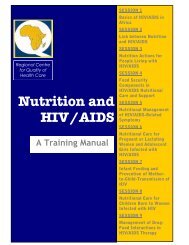Cost and Effective Analysis of the LINKAGES ... - Linkages Project
Cost and Effective Analysis of the LINKAGES ... - Linkages Project
Cost and Effective Analysis of the LINKAGES ... - Linkages Project
You also want an ePaper? Increase the reach of your titles
YUMPU automatically turns print PDFs into web optimized ePapers that Google loves.
some portion <strong>of</strong> <strong>the</strong> costs are fixed (for example, <strong>of</strong>fice space for administration), <strong>and</strong> would not bereduced if only one behavior were targeted.6.4. How Can <strong>LINKAGES</strong> Improve its <strong>Cost</strong> <strong>Effective</strong>ness?Overall Finding: Activity costs, baseline <strong>and</strong> outcome behavior rates, <strong>and</strong> size <strong>of</strong>target population are three factors that influence cost effectiveness. <strong>LINKAGES</strong> maybe able to improve its cost effectiveness by mainstreaming LAM interventions intocomprehensive MCH reproductive health programs. Spreading costs <strong>of</strong> a singleintervention through implementing integrated package <strong>of</strong> MCH activities lower cost<strong>and</strong> leads to higher cost effectiveness.Due to insufficient data, recommendations on <strong>the</strong> impact <strong>of</strong> target population arelimited. Never<strong>the</strong>less, <strong>the</strong>re appears to be an optimal size <strong>of</strong> population thatintervention activities should target. Determining an optimal population level atwhich economies <strong>of</strong> scale are realized <strong>and</strong> a different package <strong>of</strong> activities aimed atincreasing outcome behavior change in <strong>the</strong> current size <strong>of</strong> population is neededwould be a key task to improve cost effectiveness <strong>of</strong> future interventions. Fur<strong>the</strong>ranalysis is needed to make concrete recommendations.More data <strong>and</strong> fur<strong>the</strong>r analysis <strong>of</strong> <strong>the</strong> impact <strong>of</strong> <strong>the</strong> mix <strong>of</strong> activities is needed tobetter inform cost effective program design.Table 17 shows <strong>the</strong> target populations, toge<strong>the</strong>r with baseline <strong>and</strong> outcome behavior rates <strong>and</strong> <strong>the</strong>cost per new acceptor.Table 17: <strong>Cost</strong> <strong>Effective</strong>ness <strong>of</strong> Promoting LAM, <strong>LINKAGES</strong> <strong>and</strong> Partner Total <strong>Cost</strong>sNorth Center South Total<strong>LINKAGES</strong> <strong>and</strong> Partner <strong>Cost</strong>s (US$) $33,755 $43,909 $19,323 $96,988Target Population/Total Beneficiaries 17,693 20,065 6,042 43,800Percent Difference between Baseline <strong>and</strong>Outcome Rate6.78% 4.47% 3.28% 5.07%Est. Number <strong>of</strong> New LAM Acceptors 1,199 896 198 2,293<strong>Cost</strong> per New LAM Acceptor (US$) $28 $49 $98 $42Overall, low costs in <strong>the</strong> North toge<strong>the</strong>r with this high increase in <strong>the</strong> LAM behavior changeoutcomes result in <strong>the</strong> lowest cost per new acceptor <strong>and</strong> <strong>the</strong>refore <strong>the</strong> highest cost effectiveness. For<strong>the</strong> North <strong>and</strong> Center, where <strong>the</strong> size <strong>of</strong> <strong>the</strong> target population is relatively similar, <strong>the</strong> behavior rateschange is <strong>the</strong> major factors that determined cost effectiveness. These same factors help explain why<strong>the</strong> South region, which shows <strong>the</strong> South is less cost effective than <strong>the</strong> o<strong>the</strong>r regions. Additionally, <strong>the</strong>cost per new acceptor is more than 3.5 times higher in <strong>the</strong> South than in <strong>the</strong> North <strong>and</strong> two timeshigher than in <strong>the</strong> Center. This is explained by <strong>the</strong> o<strong>the</strong>r factor – target population, which issignificantly lower in <strong>the</strong> South than in <strong>the</strong> North or Center. In this case, <strong>the</strong> targeted behavioroutcomes <strong>and</strong> <strong>the</strong> size <strong>of</strong> <strong>the</strong> target population toge<strong>the</strong>r impact cost effectiveness. These data showthat while each <strong>of</strong> <strong>the</strong> factors alone does not explain cost effectiveness, <strong>the</strong> interplay <strong>of</strong> <strong>the</strong>se factorsdoes provide suggestions for improving cost effectiveness.<strong>Linkages</strong> <strong>Project</strong>/AED 6. Findings 25
















